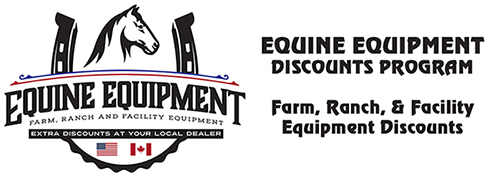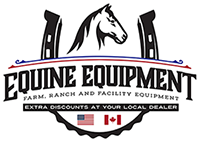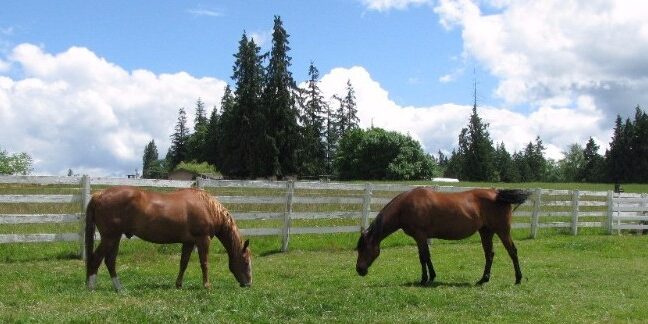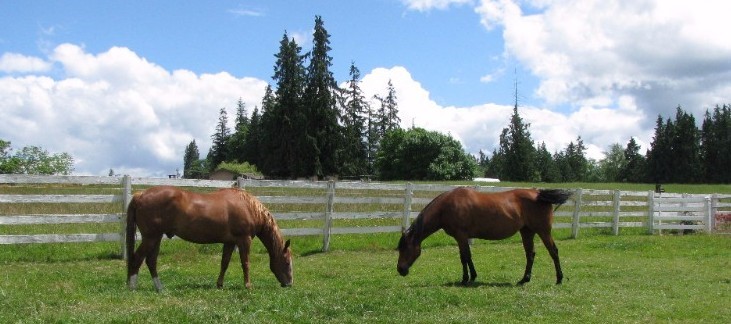
Spring Weather, Rain Rot, and Lawn Care
We’re nearing the time of year when a normal spring day can turn into a severe weather situation in just a matter of minutes. Are you prepared to keep your horses safe? Check out the articles below on preparing for severe weather, keeping your horses safe from rain rot, and when the rain starts to nourish your lawn, we’ve got tips for how to care for it as well.
Prepare Your Horses for Spring Severe Weather

When it comes to severe storms, horse owners need to take proactive steps to ensure the safety and well-being of their equine companions. Here are some essential preparation tips:
- Create a comprehensive disaster plan for your family, including your animals. Review and update this plan annually.
- Ensure your horse is up to date on vaccinations for tetanus and encephalitis viruses (such as rabies, Eastern and Western equine encephalitis, and West Nile).
- Make sure your horse has two forms of identification: Permanent identification (such as a microchip, tattoo, or brand) and Temporary identification (attach a luggage-type tag to the tail and halter, using a leather halter for break-away purposes).
- Prepare a waterproof emergency animal care kit containing essential items that include: Medications, salves or ointments, Vetrap, bandages, tape, and other items you normally use for horse care.
- Clean up your property before the threat of severe weather arrives. Remove any debris or hazardous items.
- Fill clean plastic garbage cans with water, secure the tops, and place them in the barn for use after the storm.
- Assemble an emergency barn kit containing a chain saw and fuel, hammer(s), saw, nails, and other essential tools.
- Install safe fencing and holding areas around the property.
- Consider lightning suppression systems, sprinklers, and smoke detectors for high-risk buildings where animals are kept.
Remember, preparedness is key to safeguarding your horses during severe weather events. Stay informed, stay organized, and prioritize the well-being of your equine companions!
Dancing in the Rain: A Closer Look at Equine Rain Rot
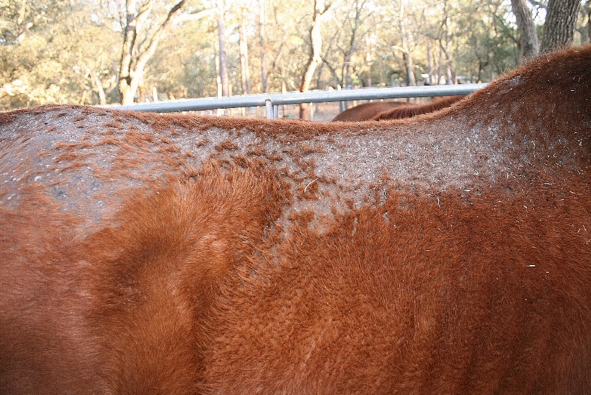
What is rain rot?
Rain rot, also known as rain scald or dermatophilosis, is a skin infection caused by a bacterium called Dermatophilus congolensis. Normally dormant on a horse’s skin, this bacterium becomes active under wet conditions, leading to an inflammatory infection. The infection results in lesions along the horse’s skin, forming small patches of raised bumps that contain clusters of hair. Removing these scabs leaves bald patches. In severe cases, the lesions and scabs can affect multiple layers of skin, impacting the horse’s use until the infection clears. Rain rot is commonly found on the horse’s topline, but it can occur in other areas like the hindquarters, face, and legs. While it doesn’t typically cause itching, rain rot can be painful and make the horse sensitive to touch.
All horses can be affected, but certain factors increase the risk.
- Coat color: Horses with lighter coat colors are more susceptible.
- Immune status: Horses with compromised or poorly developed immune systems (such as young or older horses) are at higher risk.
- Environmental conditions: Rain rot occurs when the skin has been compromised due to high humidity, prolonged rainfall, or exposure to biting insects.
Good hygiene practices, including regular bathing and grooming, help prevent rain rot. Reduce exposure to environmental factors that increase incidence. If heavy rainfall is expected, keep your horse in a barn or under shelter to minimize risk.
Bathing the horse daily with medicated shampoos is a common treatment. Topical antibacterial shampoos that contain ingredients such as chlorhexidine, povidone-iodine, or benzoyl peroxide are the most effective. Keep the horse as dry as possible between baths to enhance treatment. For severely affected or ill horses, injections of antibiotics (such as penicillin) may be necessary. Consult your veterinarian to determine the appropriate antibiotic treatment based on the severity of rain rot.
Remember, prompt attention to rain rot is crucial to prevent its spread or worsening. Prioritize your horse’s well-being and take proactive steps to manage this skin condition!
The Importance of Sharp Lawn Mower Blades: Ensuring a Clean Cut

When it comes to maintaining a lush and healthy lawn, sharp mower blades play a crucial role. Let’s explore why regular blade sharpening is essential and how it benefits both your grass and your lawnmower.
- Enhanced Cutting Efficiency: Sharp blades cut through grass like a hot knife through butter. When your mower blades are sharp, they create clean, precise cuts. Clean cuts promote faster healing for the grass, reducing the risk of diseases and pests.
- Healthier Lawns: Dull blades tear the grass rather than cutting it cleanly. These ragged cuts leave the grass vulnerable to infections and stress. By ensuring your blades are sharp, you enhance cutting efficiency and promote a healthier lawn.
- Fuel Efficiency: Sharp blades require less effort to cut through grass. As a result, your lawnmower’s engine doesn’t have to work as hard. Increased fuel efficiency means you’ll use less gasoline during each mowing session.
- Prolonged Mower Lifespan: Dull blades strain the mower’s engine and other components. Over time, this can lead to premature wear and tear. Regular blade sharpening helps prolong the lifespan of your lawnmower, saving you money on repairs and replacements.
- How to Maintain Sharp Blades: Sharpen your blades at least once a year. If you notice any bends or wear, consider replacing them. Before sharpening, clean the underside of the deck to remove grass buildup. Use a stiff bristle brush or rag to loosen debris around the blade spindle and collar area.
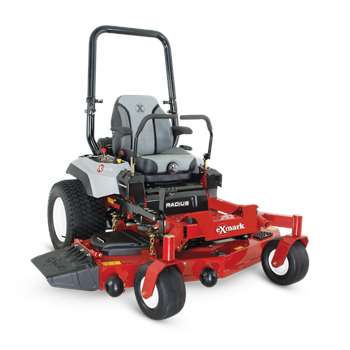
Mower of the Month!
Exmark Radius S-Series
Whether you’re upgrading from an older machine or are looking to add another zero-turn to your trailer, the new Radius S-Series delivers an unbeatable combination of durability, operator comfort, performance, and value. With just two grease points to lubricate annually, low-maintenance Hydro-Gear integrated transmissions, and reliable Kawasaki commercial engines, Radius S-Series models are built for the long haul. Choose from 48-, 52-, or 60-inch UltraCut Series 3 side-discharge cutting decks. The Radius S-Series is the introductory mower for the Equine Equipment Discount Program.
Choosing the Right Grass for Your Region: A Guide to Planting and Timing
Creating lush pastures starts with selecting the right grass type for your specific location. Whether you’re in the northern half of the U.S. with cooler climates or the southern half with warmer temperatures, understanding the best grasses and planting times is essential.
Cool-Season Grasses (Northern U.S.)
Cool-season grasses thrive in regions with colder winters and moderate summers. Here are some popular cool-season grasses and when to plant them:
Kentucky Bluegrass:
- USDA Zones: 2 to 6
- Planting Time: February to May and September to November
- Ideal for lawns in the North, Midwest, and Pacific Northwest.
Tall Fescue:
- USDA Zones: 4 to 7
- Planting Time: Spring or fall (fall is best)
- Known for its durability and adaptability to various soil types.
Creeping Red Fescue:
- USDA Zones: 3 to 7
- Planting Time: Spring or fall (fall is best)
- Excellent for shady areas and erosion control.
Warm-Season Grasses (Southern U.S.)
Warm-season grasses thrive in hot climates and tolerate high temperatures. Here are some warm-season grasses and their planting windows:
Bermudagrass:
- USDA Zones: 7 to 10
- Planting Time: March through August
- Drought-tolerant and ideal for sunny pastures.
Zoysiagrass:
- USDA Zones: 5 to 10
- Planting Time: April to August
- Known for its dense growth and resilience.
Some other grasses to consider:
- Buffalograss: Ideal for low-maintenance lawns in USDA Zones 5 to 8 (plant in spring).
- Centipedegrass: Suited for USDA Zones 7 to 10 (plant in spring/summer).
- Ryegrass (Perennial): Great for overseeding cool-season lawns (plant in spring or fall).
- Bahiagrass: Thrives in USDA Zones 7 to 11 (plant in spring/summer).
Remember to check your specific USDA zone, assess your pasture’s sunlight exposure, and choose the grass type that suits your climate. Proper timing ensures successful germination and a beautiful, thriving pasture!
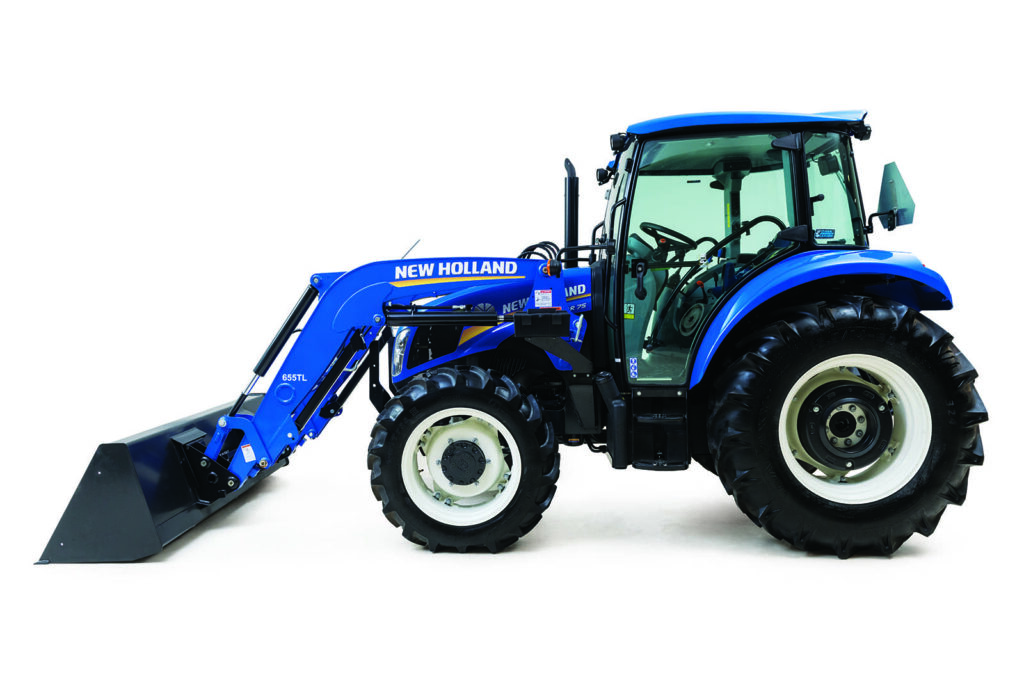
Tractor of the Month!
Powerstar 75
Power is important for a utility tractor and the PowerStar Series delivers—just as its name says. All models feature a 207-cubic-inch, four-cylinder F5C engine built by FPT. To deliver more power and torque to handle your daily chores and fieldwork with ease while simultaneously reducing your fuel bills and emissions, these engines use common rail fuel injection with four valves per cylinder.
New Holland knows the ideal 3-point and hydraulic capacities you need on a utility tractor. That’s why you’ll find a hefty 3-point hitch and impressive hydraulic capacity coupled with intuitive controls to ensure you accomplish all your tasks with power, ease, and comfort. Learn More
From the Field: Finding the Right Solution For Our Customers
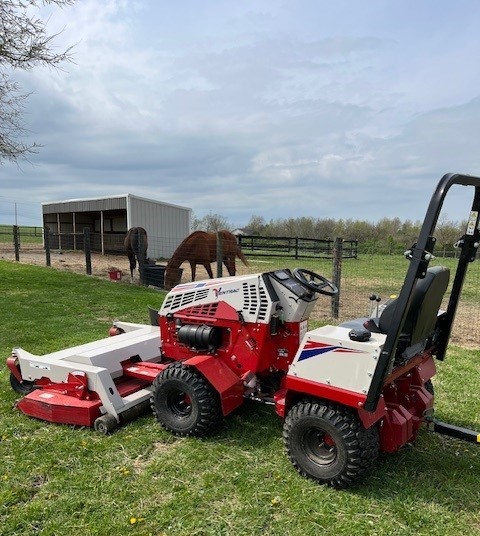
Equestrian owners take great pride in the appearance of their property as much as their horses; therefore, it’s important to find the right equipment to deliver impressive results.
Ventrac works in all kinds of situations, all kinds of weather conditions, and even very difficult terrain.
When the LeGere family reached out to Equine Equipment looking for a new tractor for their farm, we knew a Ventrac would be perfect for them!
“I love my tractor!” -Janet L., Kentucky

